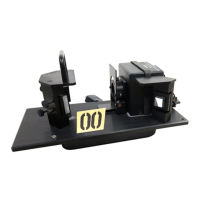AQ-00073-000, Rev. 7 18
use a chopped signal between sample and reference, this error does not occur. Double beam
spectrometers are able to accept double beam integrating spheres in which both the sample and
reference beams are placed in the sphere. Double beam spectrometers employ a chopper to
divide the instrument beam between the sample, reference, and dark channels. Although your
spectrometer is a double instrument, the RSA-PE-20 is designed as a single beam accessory to
accommodate the size of the instrument sample compartment. Since only the sample beam is
subject to sphere configuration, your RSA-PE-20 measurements are subject to substitution error.
When a sample and a reference are of similar reflectance, the substitution correction is very
small; at worst it may reach as much as 4 - 5%. In quality control applications where a threshold
value is used, this may not be a concern, as the error can simply be built into the threshold. This
is also true if only peak position information is required, as single beam correction only concerns
the photometric scale.
There are both physical and mathematical solutions to the problem of single beam substitution
error. If the sphere is made sufficiently large and the area of the sample is minimized, the error
increasingly diminishes. The use of a large sphere is usually not practical in low cost spectropho-
tometer systems due to signal-to-noise concerns as well a price considerations. The integrating
sphere on your RSA-PE-20 accessory is too small to accommodate the modifications necessary
for a physical solution.
The mathematical solution is simple in theory, but complex in practice. If a reference is used that
is very close in reflectance to the reflectance of the sample, the substitution error becomes negli-
gible. If the user can match the reference reflectance to the reflectance of the sample, or has a
large database of different level photometric reflectance standards, one can set up look-up or cor-
rection tables to correct for the substitution error.
Tables 4 and 5 show reflectance values for twelve levels of photometric gray scale. Table 4 pro-
vides data for gray Spectralon exhibiting diffuse reflectance characteristics under 50%. Table 5
provides the data for Spectralon reflectances greater than 50%. The italicized values are the
actual reflectance of samples of Labsphere SRS-XX gray scale reflectance material. These
reflectance values were determined by measuring the corrected 8°/ hemispherical reflectance
factors using a Labsphere double beam spectrometer and a double beam accessory with a 150
mm diameter integrating sphere. The second set of reflectance values in regular print were mea-
sured on a spectrometer equipped with a Labsphere 50 mm single beam integrating sphere
accessory.

